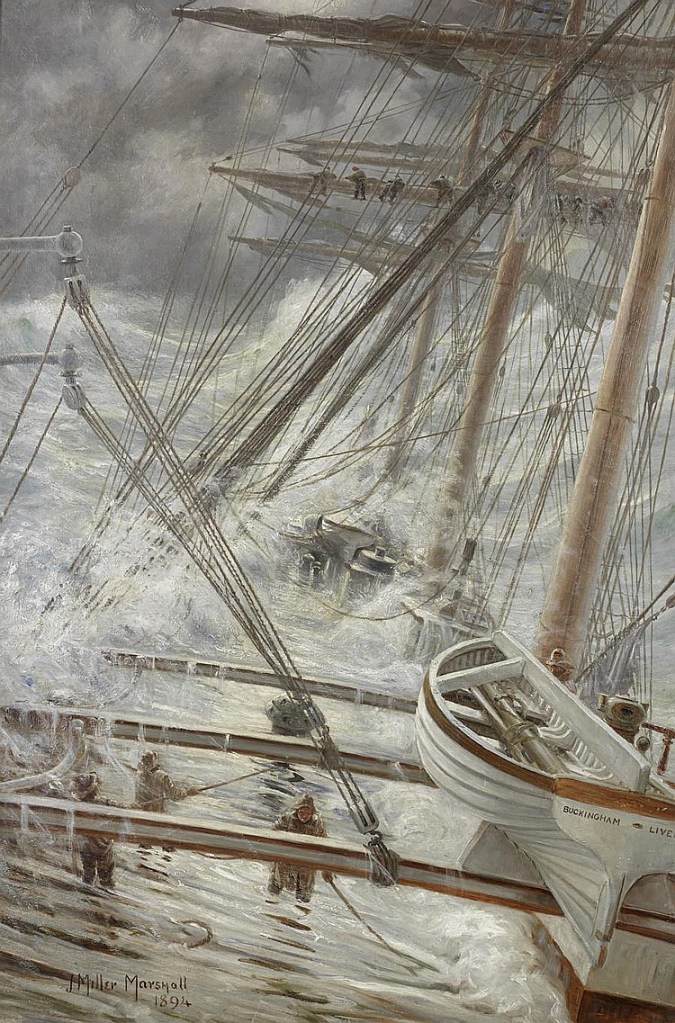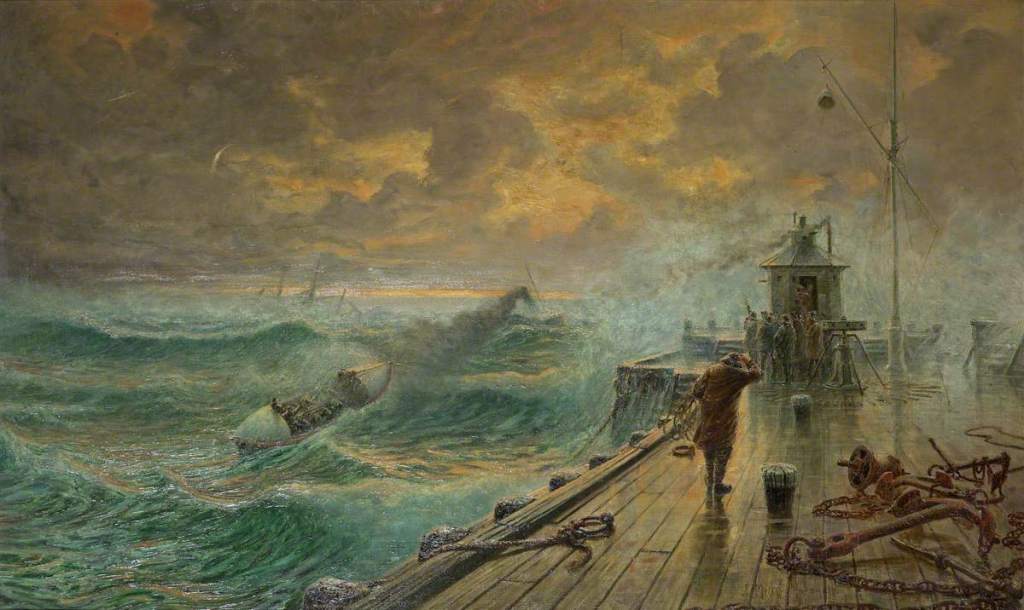Continuing our series showcasing masterpieces from the permanent collection of the RWA, writer Rob Campell finds eternal resonances in an early 20th century nautical painting…
By Rob Campbell
One of the joys of randomly browsing the RWA’s collection online is the way a single image may lead one’s mind on a journey to places old and new, making connections at first personal and then universal.
Many of us will, I imagine, be familiar with the phrase For Those In Peril On The Sea, from a hymn. It’s also the title of an oil-on-canvas work by John Miller Marshall (1858–1935), dated 1913 and presented by Mrs J. Miller Marshall.
The title is of course the crucial chorus line from Eternal Father, Strong To Save, often known as the Naval Hymn thanks to its adoption by seafarers and those who care about them.
The song’s haunting line about peril on the sea must have been in Marshall’s mind as he painted a livid sky beneath which roaring waves toss a boat apparently struggling towards, or returning from, a stricken ship, the masts of which are tilting at a dreadful angle far out towards the horizon. Figures stand on a pier, watching and perhaps helping in some way. It’s a fearful drama.
I won’t guess any further at what’s going on in the picture, given my ignorance of all things nautical. I grew up near London, believed the Thames Estuary was the ocean, and my only sailing was in a dinghy on a placid reservoir. My late father was a submariner during his post-war National Service but I forgot (as children stupidly do) to ask him much about it.
Why, then, does Marshall’s image and the hymn from which it takes its name resonate so much to us, whether we are landlubbers or old salts?
We might perhaps have heard echoes of Eternal Father being sung in churches on Sea Sunday, in July, not least by those supporting the Mission For Seafarers which started life as the Bristol Channel Mission in 1836. The Mission was conceived by the Anglican minister John Ashley, as he stood on the shore at Clevedon, wondering how to help sailors stranded far from home in our local waters and ports.
Or we might have heard the hymn, as I first did, while watching the 1983 film The Right Stuff, based on Tom Wolfe’s book of the same name about America’s space race test pilots. It was a variation of the hymn, about the courage of those in peril in the air, sung by the gloomiest of chaplains at a young aviator’s heart-breaking funeral.
Eternal Father, it seems, is eternally adaptable. As is the message in Marshall’s painting, viewed now against a backdrop of modern headlines about desperate people taking to small boats across the English Channel. Some were rescued by the RNLI on the day I wrote this post, and some have recently found themselves still at sea albeit on a bigger boat (the Bibby Stockholm, recently towed from its upgrading in Falmouth to bob about off Portland with 500 men on board).
But back to Marshall’s painting. It speaks first of terror, but two better things stand out. The first is hope, in the way that the pier leads us out towards peril, before we are drawn back in an arc towards the smaller boat, the pier’s timbers, and the possibility of dry land that we must assume is nearby. The second is courage: there are people on that small boat and that distant ship, and people at the far end of the pier framed by spray, all invested in the saving of lives. For me, at least, that portrayal of courage feeds the hope of which there is a hint in the play of light in Marshall’s sky.

What of Marshall himself? Online research suggests he was initially Norfolk-based, a member of the Norwich Art Circle, spent some of the 1890s painting and teaching in Australia, then returned to Britain and married in Bristol in 1900. Perhaps the sea was in his blood, too, after the long sail to the other side of the world and back. Back in Britain he settled in Teignmouth and Minehead, and produced work featuring Bristol Docks, Porlock Weir and Teignmouth Harbour. According to the database of Design and Art Australia Online, from which some of the biographical details above are gleaned, Marshall also exhibited a painting titled Caught in a Cyclone in the 1894 Royal Academy Summer Exhibition, which sold at Bonhams in 2012.
I don’t know if Marshall was ever himself in peril on the sea but he did leave behind an image that is as remarkably powerful, and as pertinent, as it was more than a century ago.

Title: For Those in Peril on the Sea (1913)
Artist: John Miller Marshall (1858–1935)
Material: oil on canvas 64 x 107cm
Accession number: 1021
Rob Campbell is a freelance writer and editor. View his website here.

